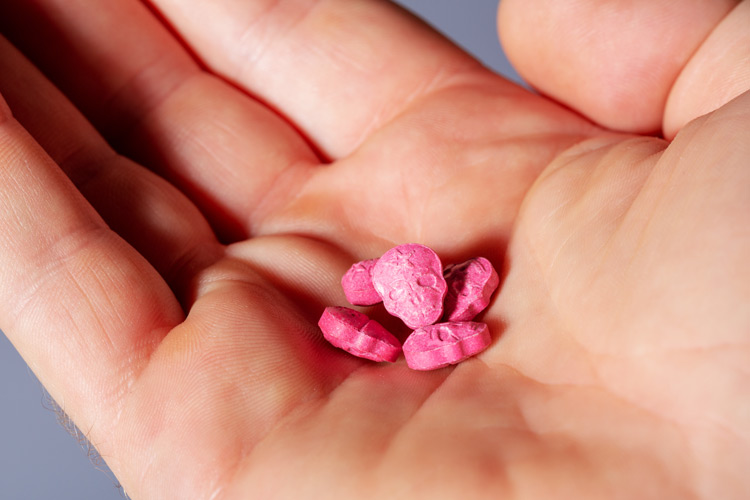 Ecstasy tablets often look like candy, but they’re definitely not a harmless treat. These brightly colored tablets are frequently decorated with imprints of cartoon characters or product logos and sold on stretchy candy necklaces to be worn at raves or concerts. However, the hallucinogenic and stimulant effects of the drug can lead to a wide range of addiction-related problems affecting a person’s health, cognitive function, and relationships with others.
Ecstasy tablets often look like candy, but they’re definitely not a harmless treat. These brightly colored tablets are frequently decorated with imprints of cartoon characters or product logos and sold on stretchy candy necklaces to be worn at raves or concerts. However, the hallucinogenic and stimulant effects of the drug can lead to a wide range of addiction-related problems affecting a person’s health, cognitive function, and relationships with others.
About Ecstasy
Ecstasy is the street name for a version of MDMA, or 3,4 methylenedioxymethamphetamine. Common slang terms for ecstasy include E, X, XTC, skittles, sweets, smartees, scooby snacks, candy, happy pills, beans, and adam.
Ecstasy is a derivative of amphetamine and has a similar structure to methamphetamine. It is synthesized in a lab by slightly altering the structure of the amphetamine molecule. The majority of the ecstasy available in the United States is either manufactured overseas or in Canada before being smuggled into the country.
Ecstasy Is Often Contaminated
One often-overlooked risk factor associated with illegal drug use is that it’s impossible to know what’s really in the substance a person is using. Ecstasy is often cut with other drugs to either increase the high or stretch the product to make it more profitable for the dealer. In fact, several studies have identified MDMA as one of the most frequently contaminated drugs on the market.
Some contaminants often found in ecstasy include:
- Aspirin
- Caffeine
- Methamphetamine or amphetamine
- Heroin
- Cocaine
- LSD
- Bath salts
- Fentanyl
- Rat poison
There have also been cases where samples of drugs being sold as ecstasy on the street have been found to contain no MDMA at all—just an assortment of substances increasing the risk of allergic reactions, seizures, overdoses, or poisonings.
A Gateway Drug
A gateway drug is a substance that often leads to experimenting with other addictive substances. Ecstasy can be thought of as a gateway drug because its use is linked to an increased likelihood that an individual will go on to use marijuana, inhalants, cocaine, methamphetamine, LSD, or heroin.
For those who are part of the rave culture, use of ecstasy with cocaine and methamphetamine is the most common form of poly-drug use. Cocaine, methamphetamine, and ecstasy are all stimulants, so using the three drugs together can create a more intense high or compensate for the tolerance that develops when a person uses ecstasy regularly.
Signs of Ecstasy Use
Ecstasy use is often marked by noticeable changes in mood and behavior. For example:
- Having an unusual amount of energy
- Being abnormally friendly and talkative
- Being overly affectionate with strangers
- Irregular sleep patterns
- Increased sensitivity to sound or light
- Impulsive or risky behavior
- Increased sexual activity—often with multiple partners
- Being unable to feel pain when accidentally injured
A person who has been using ecstasy may also complain of nausea, muscle cramps, dry mouth, chills, or sweating and have a tight or clenched jaw with dilated pupils.
While any use of an illegal drug is a concern, not all people who use ecstasy have an addiction. Since the drug is primarily used in social settings, a person may be able to stop if they are simply removed from the environment where drug use is commonplace. However, if a person is experiencing cravings and is unable to independently regulate their ecstasy use, these are strong signs that a substance abuse evaluation is needed. As with other types of drug use, an addiction to ecstasy can lead to long-term problems such as:
- Poor performance at work or school
- Lack of interest in relationships with family and friends
- Financial problems due to the amount of money spent on drug use
- Legal problems such as an arrest for drug possession
- Worsening of co-occurring mental health disorders such as anxiety and depression
Overdose Risks
People are less likely to overdose on ecstasy than other illegal substances. However, it’s still possible to overdose—especially if it is being combined with alcohol or additional drugs or the ecstasy itself has been contaminated.
An overdose is dangerous because it will cause a person’s body temperature to spike. This can lead to heatstroke or aggravate an underlying heart condition. Chest pain, seizures, and confusion are possible signs of an overdose. To avoid fatal complications, call 911 for immediate medical attention.
Getting Help
Substance use disorders are progressive conditions, so someone who is addicted to ecstasy won’t get better without access to a comprehensive, evidence-based care program. At St. Joseph Institute for Addiction, we provide personalized care for men and women struggling with drug and alcohol addiction. Detox is followed by intensive individual, group, and family counseling at our Pennsylvania residential treatment center. Holistic support services are also provided to promote the development of a wellness-focused lifestyle marked by good nutrition, regular exercise, spiritual growth, and a connection to the wider recovery community. Our focus is on healing rather than casting judgment or condemnation on those who need our help.
Looking for a Pennsylvania addiction rehab center? To learn more about SJI drug and alcohol treatment center in Pennsylvania, and our programs, please contact us at (814) 228-8881.

